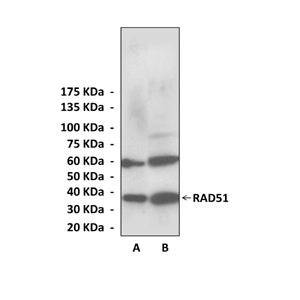Anti-RAD51: Rabbit RAD51 Antibody |
 |
BACKGROUND Homologous recombination (HR) functions in accurate chromosome segregation during meiotic cell division. Defects in meiotic homologous recombination in mice cause infertility, indicating its required function in meiosis. Homologous recombination also has essential functions in the repair of DNA double strand breaks (DSBs) and the rescue of stalled replication forks during mitosis. The homologous-recombination defects in mitosis cause instability of the genomic DNA, leading to chromosomal aberrations and tumorigenesis. Therefore, homologous recombination is essential for both meiotic and mitotic cell divisions. RAD51, a eukaryotic homologue of bacterial RecA, is a central DNA recombinase, which functions in both meiotic and mitotic homologous recombination and recombinational repair of double strand breaks. During the homologous-recombination process, RAD51 promotes the key recombination reactions, homologous pairing and strand exchange, in an ATP-dependent manner. To promote homologous pairing, RAD51 first binds to single-stranded DNA (ssDNA), which is produced at the DSB site, and forms helical nucleoprotein filaments often referred to as the presynaptic filament in which the DNA is stretched by ≈50% over its normal B-form length. The presynaptic filament, at saturation, comprises 1 Rad51 monomer for every 3 nucleotides or base-pairs of DNA. The RAD51–ssDNA filaments then bind to intact double-stranded DNA (dsDNA). The homologous sequences are aligned between ssDNA and dsDNA, and new Watson–Crick base pairs (heteroduplex) are formed between the ssDNA and the complementary strand of the dsDNA within the RAD51–ssDNA–dsDNA filament. This step is called homologous pairing. The heteroduplex region formed by homologous pairing is further expanded by the RAD51-mediated strand exchange reaction. RAD51 requires cofactors for efficient promotion of the homologous-pairing and strand-exchange reactions. In humans, RAD52, RAD54, RAD54B, RAD51B–RAD51C, RAD51AP1 and BRCA2 have been reported as such cofactors for the RAD51-mediated homologous pairing and/or strand exchange reactions in vitro.1,2 BRCA2 controls the RAD51 recombinase in different way. BRCA2 binds RAD51 via eight conserved BRC repeat motifs of approximately 35 amino acids, each with a varying capacity to bind RAD51. BRC repeats both promote and inhibit RAD51 assembly on different DNA substrates to regulate HR reaction.3
In vivo, the process of HR is tightly regulated by various mechanisms. Whereas some proteins promote HR, others inhibit this process, thereby preventing its untimely initiation. Disruption of the Rad51-ssDNA nucleoprotein filament appears to be an especially important mechanism of controlling HR. This filament disruption activity was demonstrated for the yeast Srs2 helicase and human RECQ5 helicase. It was also found that BLM, a helicase of the RecQ family, can also catalyze disruption of the RAD51-ssDNA filament. This disruption only occurs if the filament is present in an inactive ADP-bound form, e.g. in the presence of Mg2+. Conversion of RAD51 into an active ATP-bound form, e.g. in the presence of Ca2+ , renders the filament resistant to BLM disruption. However, when BLM interacts with an active ATP-bound RAD51-ssDNA filament, it stimulates the DNA strand exchange activity of RAD51. Thus, depending on the conformational state of the RAD51 nucleoprotein filament, BLM may either inhibit or stimulate the DNA strand exchange activity of RAD51.4 In addition, Human PSF was identified as a component of spliceosomes. It was shown that PSF directly interacted with RAD51. PSF significantly enhanced RAD51-mediated homologous pairing and strand exchange at low RAD51 concentrations; however, in contrast, it inhibited these RAD51-mediated recombination reactions at the optimal RAD51 concentration.
In vivo, the process of HR is tightly regulated by various mechanisms. Whereas some proteins promote HR, others inhibit this process, thereby preventing its untimely initiation. Disruption of the Rad51-ssDNA nucleoprotein filament appears to be an especially important mechanism of controlling HR. This filament disruption activity was demonstrated for the yeast Srs2 helicase and human RECQ5 helicase. It was also found that BLM, a helicase of the RecQ family, can also catalyze disruption of the RAD51-ssDNA filament. This disruption only occurs if the filament is present in an inactive ADP-bound form, e.g. in the presence of Mg2+. Conversion of RAD51 into an active ATP-bound form, e.g. in the presence of Ca2+ , renders the filament resistant to BLM disruption. However, when BLM interacts with an active ATP-bound RAD51-ssDNA filament, it stimulates the DNA strand exchange activity of RAD51. Thus, depending on the conformational state of the RAD51 nucleoprotein filament, BLM may either inhibit or stimulate the DNA strand exchange activity of RAD51.4 In addition, Human PSF was identified as a component of spliceosomes. It was shown that PSF directly interacted with RAD51. PSF significantly enhanced RAD51-mediated homologous pairing and strand exchange at low RAD51 concentrations; however, in contrast, it inhibited these RAD51-mediated recombination reactions at the optimal RAD51 concentration.
REFERENCES
1. Morozumi,Y. et al: Nucleic Acids Res. 37:4296-307, 2009
2. Urena, D. E. et al: J. Mol. Biol. 2010 in press
3. Rajendra, E. & Venkitaraman, A.R.: Nucl. Acids Res. 38:82-96, 2010
4. Bugreev, D.V. et al: J. Biol. Chem. 284:26349-59, 2009
2. Urena, D. E. et al: J. Mol. Biol. 2010 in press
3. Rajendra, E. & Venkitaraman, A.R.: Nucl. Acids Res. 38:82-96, 2010
4. Bugreev, D.V. et al: J. Biol. Chem. 284:26349-59, 2009
Products are for research use only. They are not intended for human, animal, or diagnostic applications.
Параметры
Cat.No.: | CA1219 |
Antigen: | Short peptide from human RAD51 sequence. |
Isotype: | Rabbit IgG |
Species & predicted species cross- reactivity ( ): | Human |
Applications & Suggested starting dilutions:* | WB 1:1000 IP n/d IHC 1:50 - 1:200 ICC n/d FACS n/d |
Predicted Molecular Weight of protein: | 37 kDa |
Specificity/Sensitivity: | Detects endogenous levels of RAD51 proteins without cross-reactivity with other related proteins. |
Storage: | Store at -20°C, 4°C for frequent use. Avoid repeated freeze-thaw cycles. |
*Optimal working dilutions must be determined by end user.
Документы
Информация представлена исключительно в ознакомительных целях и ни при каких условиях не является публичной офертой








